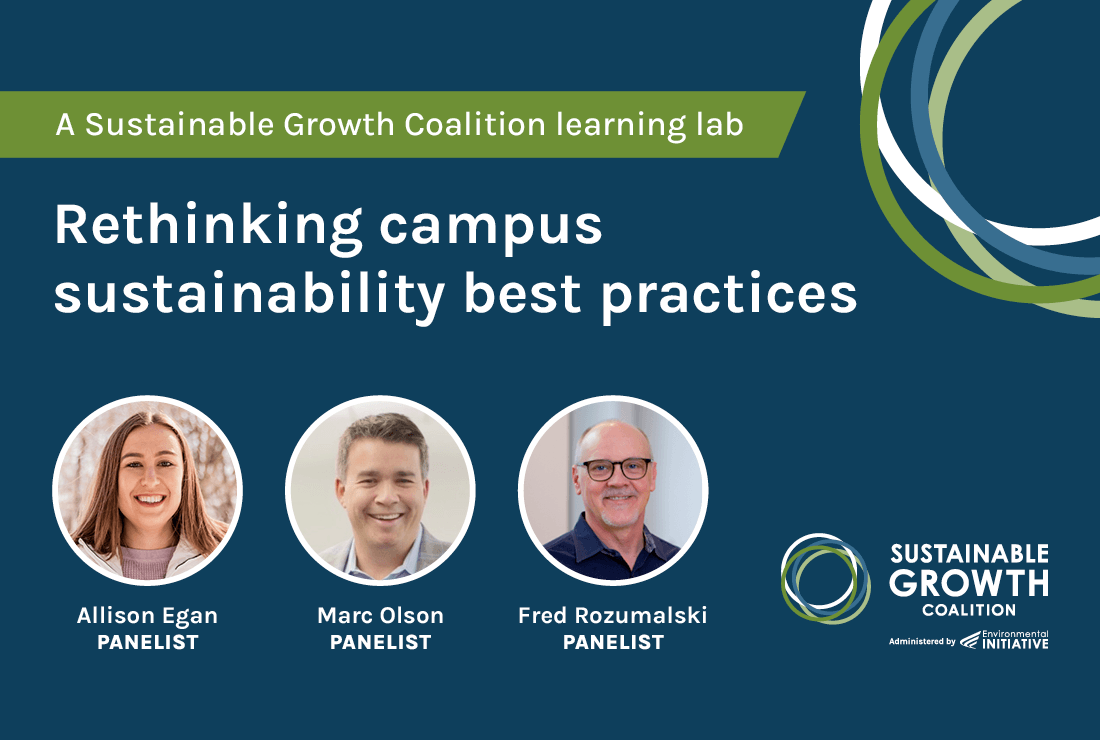Rethinking campus sustainability: A panel discussion recap

Late last month, members of the Sustainable Growth Coalition convened in person for a discussion about campus sustainability at the Shakopee Mdewakanton Sioux Community’s (SMSC) LINK event center in Prior Lake, Minn. Members had the opportunity to learn about SMSC’s sustainable building design, green roofs, parking lot stormwater solutions, and waste diversion goals. Our sincere thanks to SMSC for providing meeting space for us and for sharing their stewardship and sustainability efforts with members.
Part of the day also included a short hybrid conversation on campus sustainability programs featuring:
- Allison Egan, program sustainability manager at HealthPartners.
- Marc Olson, vice president of policy and producer administration and lead environmental officer at Allianz Life.
- Fred Rozumalski, ecologist and landscape architect at Barr Engineering.
They discussed sustainable landscaping approaches, how corporate campuses have been evolving since the early days of the pandemic, and the power of passionate people to affect change. Here are our takeaways from their conversation:
Redesign for the new reality
With 74% of U.S. companies using or planning to implement a permanent hybrid work model, office campuses and how they are utilized are rapidly changing. At Allianz Life, they are leaning into the change and thinking strategically about how their Golden Valley office space could and should be used.
Their goal is to continue to provide employees with flexibility, while balancing the need for in-person work, and keeping true to their culture, especially as new employees are being onboarded. The company has spent time analyzing the needs of different departments for in-person and remote work. In 2021, they engaged an architecture firm to assist them with redesigning the space. They are piloting changes and seeking input from employees as they make decisions about individual work, private meeting, and collaboration space.
“It’s been a journey and will probably be a few more years until we fully operationalize all the changes. Employee feedback is important, because we don’t want to do something that has unintended consequences,” Marc Olson, Allianz Life.
Creating landscapes that work
Many office complexes and corporate campuses are surrounded by lawn or turf, which can be time and resource intensive to maintain. Fred Rozumalski shared photos and stories of sustainable landscape projects through his work at Barr Engineering. Watch Fred’s six-minute presentation.
Sustainable landscaping projects have multiple benefits including conserving water, providing habitat, reducing fertilizer use, and burning fewer fossil fuels. “Lawns are very consumptive. We irrigate. We fertilize. We mow; when a landscape can do many other things like create habitat and create beautiful spaces for people,” said Rozumalski.
Removing hard surfaces and replacing them with native landscapes is another opportunity businesses and organizations should consider. As commuting patterns continue to change, organizations may not need the same amount of parking space that was needed prior to the COVID-19 pandemic. Parking lots and parking ramps could be reduced or reimagined to decrease the amount of hard surface, reduce runoff, create habitat, and provide outdoor space for people to enjoy.
Converting from a turf grass lawn to a natural, native landscape can cost more in the first year of implementation, compared to the existing cost to upkeep a turf lawn. However, with five acres or more converted, payback often occurs in as little as two years. Once established, the maintenance costs of natural and prairie plantings can be as low as one-tenth the cost of maintaining a lawn. To explore different landscaping project types, create your plan, and write a business case, explore the Sustainable Growth Coalition’s Corporate Guide to Sustainable Landscaping.
Passionate people make the difference
Green teams, whether they are structurally embedded in sustainability departments or employee led, are critical in helping organizations move the needle on organizational goals. HealthPartners is an integrated healthcare system with eight hospitals, roughly eighty clinics, and 27,000 employees. Their green teams are led by employees who go above and beyond in their day jobs.
Despite the challenges of the COVID-19 pandemic, HealthPartners hospital green teams kept their waste minimization and recycling work going. Site-based green teams were established in the late two-thousands, starting with Hudson hospital. With several years of waste minimization work under their belts, the work could continue despite the challenges presented by the pandemic.
“Green teams at our hospitals include facility leaders, supply chain experts, and clinical staff. These are the folks really getting the work done on the ground,” said Allison Egan. “I’m so thankful for their passion, issue expertise, and on-site knowledge.”
Not all sites across the network are equipped or ready for green teams at this stage. To build capacity and interest, HealthPartners has rolled out a green champions program. Allison writes and sends monthly newsletters on timely and universal sustainability topics to share resources and ideas. She also hosts quarterly meetings to answer questions or host guest speakers on sustainability. This lower barrier to entry tool is one way HealthPartners is building interest, engagement, and capacity across their system.
Corporate campus sustainability will continue to evolve as the way many of us work continues to change. Redesigning spaces, transforming outdoor landscapes, and supporting engaged employees are just a few ways companies are navigating the change. To learn more about the Sustainable Growth Coalition, or to access the audio recording or event transcript, contact Britta Dornfeld.
The Sustainable Growth Coalition meets quarterly to network, learn, and harness their expertise to advance the next frontier of corporate sustainability – the circular economy. Watch our website for another hybrid event this September focused on embodied carbon. (Embodied carbon refers to the amount of greenhouse gas emissions produced throughout the entire life cycle of a product, including its extraction, manufacturing, transportation, use, and disposal).